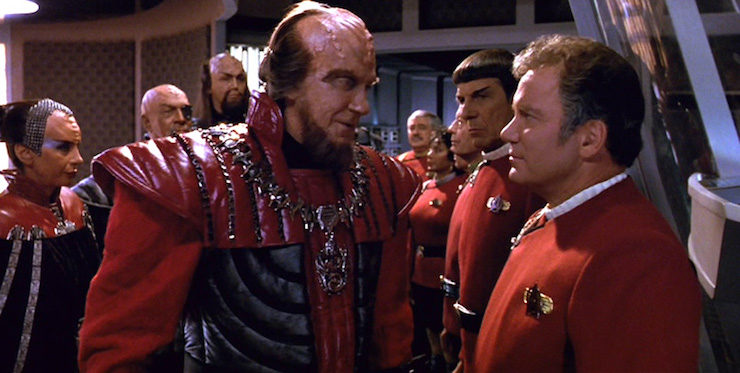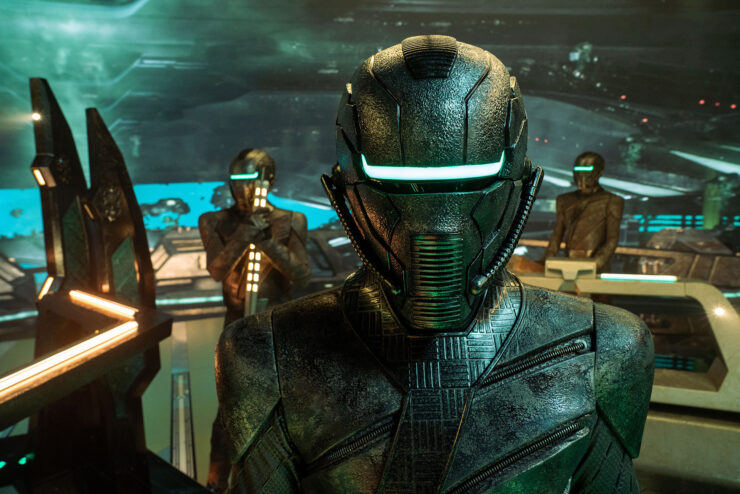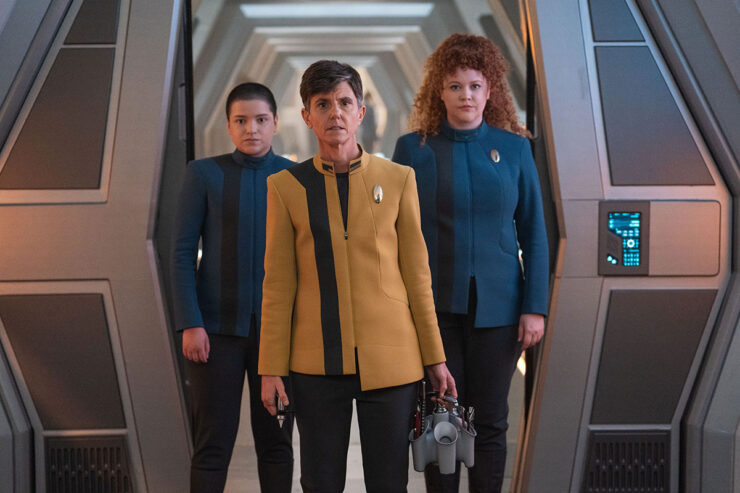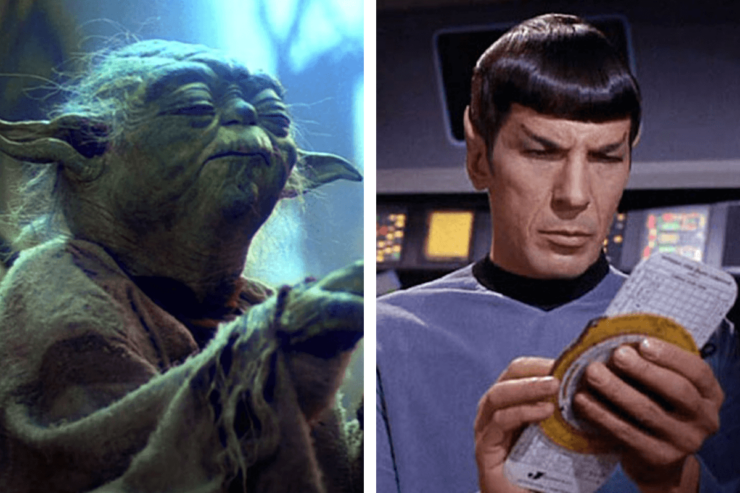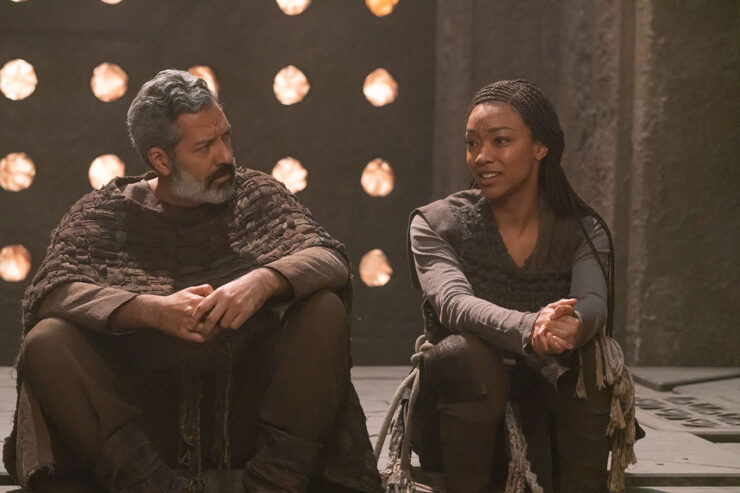Star Trek VI: The Undiscovered Country
Written by Leonard Nimoy and Lawrence Konner & Mark Rosenthal and Nicholas Meyer & Denny Martin Flynn
Directed by Nicholas Meyer
Release date: December 6, 1991
Stardate: 9521.6
Captain’s log. We open with the explosion of Praxis, a Klingon moon, and the location of their primary energy production facility. The subspace shockwave from the explosion travels all the way to Federation space, where the U.S.S. Excelsior, under the command of Captain Sulu, is returning from a three-year survey of the Beta Quadrant, charting gaseous anomalies. The Excelsior is hit by the wave, which Science Officer Valtane traces to Praxis—but while he can confirm the location of Praxis, he can’t confirm the existence of Praxis. Most of the moon is gone. Sulu has Communications Officer Rand send a message asking if they require assistance. A distress call from the moon is overlaid by Brigadier Kerla, who responds to Sulu’s offer of help with a definitive “no,” calling it an “incident” that they have under control. Sulu is, to say the least, skeptical and has Rand report this to Starfleet Command.
Two months later, Kirk, McCoy, Scotty, Uhura, and Chekov are summoned to a classified briefing at Starfleet Headquarters. This surprises them, as they’re due to stand down and retire in three months. The other attendees are all admirals and captains. The Starfleet commander-in-chief announces that the Klingon Empire has only fifty years of life left, then turns the briefing over to the Federation Special Envoy: Spock. He explains that the destruction of Praxis will render the Klingon homeworld uninhabitable within five decades, and that Spock—at Sarek’s behest—has reached out to Chancellor Gorkon to discuss a peace treaty.
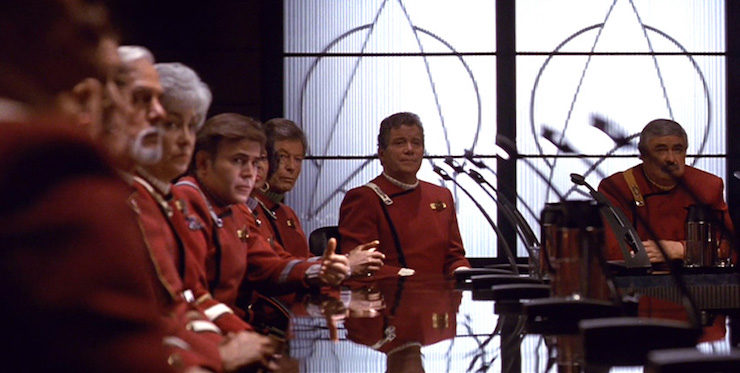
Cartwright is dead set against this course of action, and so is Kirk, feeling the Klingons are untrustworthy. So the captain is rather surprised to find that Spock has volunteered the Enterprise to escort Gorkon’s flagship to Earth for negotiations.
The meeting breaks up, leaving Kirk and Spock alone. Kirk is livid that Spock volunteered him, as he doesn’t trust the Klingons. When Spock points out that they’re dying, Kirk’s rather appalling response is, “Let them die.”
However, Kirk takes command, meeting Lieutenant Valeris, one of Spock’s protégés, who has volunteered to serve as helm officer. Valeris later overhears the end of Kirk’s log entry because Kirk left the door to his cabin open for no compellingly good reason. The log in question discusses how Kirk has never trusted the Klingons and how he can’t forgive them for the death of David.
Later, Valeris meets with Spock in his quarters to share a drink. He indicates that he’s grooming her to serve on the Enterprise, eventually to take command of her, as he will be retiring from Starfleet and entering diplomatic service. He also reminds her that logic is the beginning of wisdom, not the end of it.
The Enterprise rendezvouses with Kronos One. Kirk muses that he’s never been this close to a Klingon ship, having apparently forgotten that he’s been on one in each of the last three films. Kirk and Gorkon speak, and Kirk invites Gorkon to dinner on the Enterprise, then grumbles, “I hope you’re happy” at Spock like a sullen teenager after the chancellor accepts. Chekov mutters, “Guess who’s coming to dinner?” and Valeris offers to have Romulan Ale be served at the dinner. (Kirk’s approving response: “Officer thinking, Lieutenant.”)
Gorkon, his daughter Azetbur, Kerla, General Chang, and two bodyguards beam aboard. Chang fangoobers Kirk, and after he takes them off for a tour, the two security guards, Burke and Samno, make racist comments about how Klingons all look alike and smell bad, until they are rebuked by Valeris.
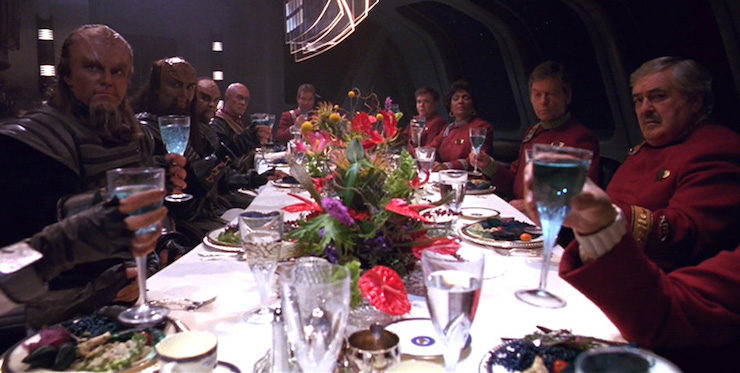
At the dinner, the Klingons are befuddled by the silverware, and then Gorkon offers a toast to “the undiscovered country”—which makes everyone uncomfortable, until he explains that he’s referring to the future, not death, as Hamlet was. It’s the first of several Shakespeare quotes, including Chang saying, “to be or not to be” in Klingon.
Attempts at conversation are hesitant and awkward, with the humans far more uncomfortable than the Klingons or the half-Vulcan. Kirk at one point even Godwins the conversation by noticing that Chang makes a comment about needing breathing room, which Kirk cites as a Hitler quote.
After dinner, the Klingons beam off, with Gorkon telling Kirk that he knows the captain doesn’t trust him, and that if there is to be a brave new world, it is their generation that will have the hardest time of it.
Once they dematerialize, the Enterprise crew sighs with relief, Uhura and Chekov decrying the Klingons’ table manners, Spock tartly reminding them that their own behavior was pretty damned wretched. Kirk wanders off to sleep the evening off, asking folks to let him know if there’s another way they can screw the evening up. He makes a note to the galley that Romulan Ale is never to be served at diplomatic functions.
Spock summons Kirk to the bridge, as he is detecting a large amount of neutron radiation. Then a torpedo fires on Kronos One, seemingly from the Enterprise, quickly followed by another. The second shot knocks the gravity out on the Klingon ship. Even as Scotty reports that the Enterprise still has all its torpedoes, two people in Starfleet security armor (complete with magnetic boots) beam to the Klingon ship, killing or maiming dozens of Klingons along the way before finally getting to Gorkon and assassinating him.
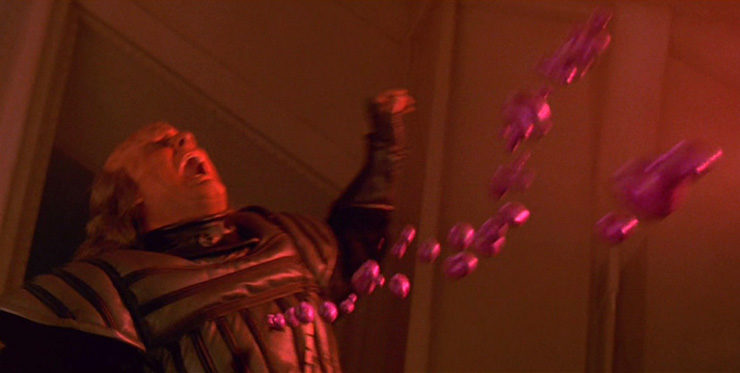
The assassins beam back. Chang accuses Kirk of firing on them without provocation, and Spock verifies that the Enterprise did fire, even though they have all their torpedoes. Kirk surrenders and beams over with McCoy, refusing to start a war on the eve of peace. Spock very deliberately touches Kirk’s shoulder in a manner that we’re supposed to notice. That will probably be important later.
Kerla almost fires on Kirk and McCoy as soon as they dematerialize, but he is willing to give Kirk’s denial the benefit of the doubt and bring them to Gorkon. The ship’s surgeon is also dead, so McCoy offers to try to revive the chancellor. Azetbur and Chang agree, but McCoy is unable to save him. Gorkon’s last words are to ask of Kirk, “Don’t let it end this way, Captain.”
Chang has Kirk and McCoy arrested for assassinating the chancellor. Spock assumes command, tells Uhura to fill Starfleet in and then he works to determine what, precisely, happened.
The Klingon ambassador meets with the Federation president. The president is not happy about Kirk and McCoy’s arrest, but both Sarek and Romulan Ambassador Nanclus concur that their arrest was legal. The president therefore abides, and the Klingon ambassador departs. Even as he goes, the Starfleet C-in-C, Cartwright, and Colonel West enter. They object to Federation citizens being abducted, but the president reminds them about that pesky rule of law. West displays a plan to rescue them with “acceptable” loss of life. When the president asks about the possibility of war, West boasts that Starfleet will “clean their chronometers.” The president, however, dismisses the Starfleet personnel—and Nanclus, who was inexplicably allowed to remain in this meeting that discussed military strategy despite being a diplomat from a hostile power.
The Enterprise is ordered to return to Earth. At Valeris’s suggestion, Uhura and Chekov fake a malfunction so they can’t receive communications. Scotty and Spock try to figure out why they have all their torpedoes, yet the sensors say they fired twice.
Azetbur and the president agree to try the peace conference again in one week’s time at a neutral location—but that location should be kept secret, and the conference will only happen if Kirk and McCoy are allowed to stand trial and no attempt at a rescue is made. Kerla and Chang are as eager to go to war as West and Cartwright were, but Azetbur wishes to do what her father wanted.
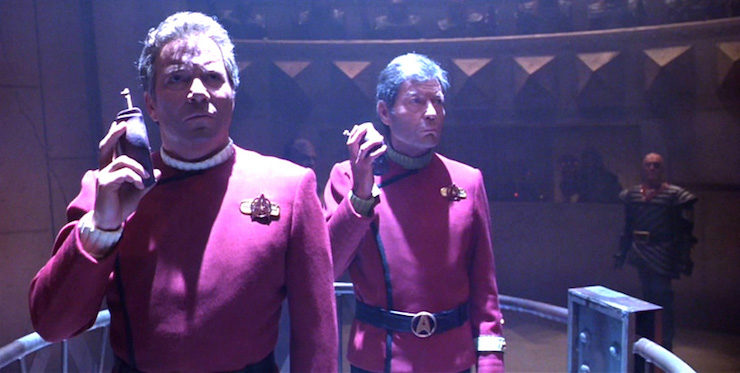
Kirk and McCoy stand trial. Chang himself prosecutes, with Colonel Worf defending. The trial is broadcast all over the galaxy, and when the magnetic boots are mentioned, Spock immediately starts a search for them. The president and some of his staff, as well as Sarek, watch from his office, as does the crew of Excelsior; Sulu has Rand send a message to the Enterprise offering assistance. Meanwhile, Chang accuses McCoy of being drunk and/or incompetent when he tried to save Gorkon, and then he uses Kirk’s earlier personal log against him to prove malice toward the Klingons on his part. He also admits that as captain, he is responsible for the conduct of his crew.
They’re found guilty, but in the interests of peace, they are not sentenced to death. Instead, they are sentenced to life in prison on Rura Penthe in the dilithium mines there.
Spock and the rest of the crew continue their investigation. They determine that there must have been a small Klingon ship that can fire while cloaked positioned beneath the Enterprise. He then has Valeris conduct a search—either the assassins came from the Enterprise, or the people who sabotaged the computer to make it look like they fired did. Or both. Either way, the saboteurs need to be found.
Kirk and McCoy arrive at the frozen wasteland of Rura Penthe. They befriend a woman named Martia, who informs them that there’s a contract out for their deaths. McCoy is, to say the least, thrilled.
Spock’s investigation continues, but there is no sign yet of the boots. He has Scotty pretend that the warp drive is down so they can’t return to Spacedock as ordered by Starfleet.
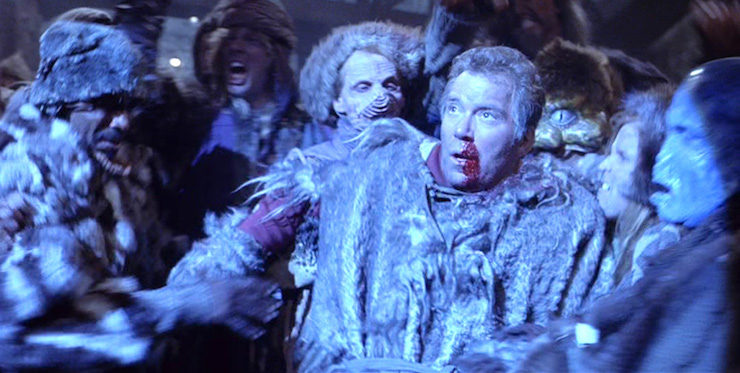
Kirk gains the respect of the other prisoners by beating one of them up, and then he and Martia smooch, because we must make sure all prison movie clichés are checked off. She has a way off the planet, but she needs a partner, and she thinks Kirk is the first person to come through Rura Penthe who can swing it.
Chekov finds traces of Klingon blood on one of the transporter platforms, and then they find magnetic boots in the locker belonging to Crewman Dax. Unfortunately, Dax is from an alien species with oversized feet, so he couldn’t possibly be the culprit.
Martia turns out to be a shapeshifter. In the form of a different alien, she accompanies Kirk and McCoy to a mining detail, then changes her shape to that of a little girl, thus sliding out of her leg irons. They sneak out through a bit of ductwork (because there’s always ductwork) and up a big rock to the surface, and thence past the magnetic field’s influence, thus freeing them to be transported.
Uhura has been keeping an eye on the transponder that Spock put on Kirk when he touched his shoulder earlier, and once she detects that it’s outside the shield, Spock has Chekov set course for Rura Penthe. Uhura bluffs her way past a listening post by using dozens of books of the Klingon language, because it’s been a few minutes since we had a scene with forced laughter, and then they proceed.
Once Kirk, McCoy, and Martia have settled down with a flare, Kirk slugs Martia. The whole escape was far too convenient. He just hopes Spock arrives before Martia’s employers, who have promised her a full pardon in exchange for getting them out. Having them killed while trying to escape will make the most convincing cover story. The warden tracks them down, shoots Martia (who has assumed Kirk’s shape, which leads to Kirk fighting himself) and is about to tell them who’s responsible before Spock beams them up. Timing is everything.
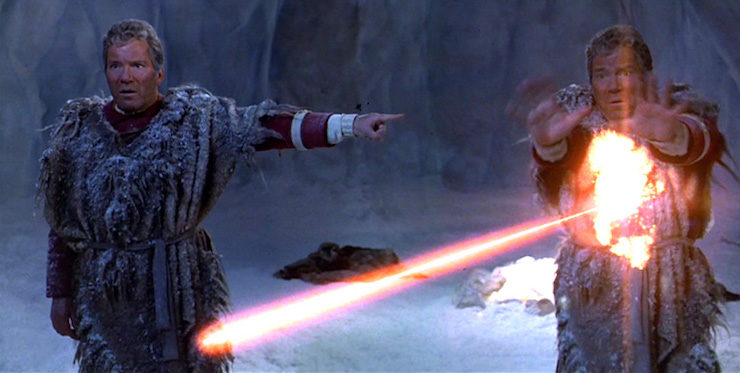
Scotty finds the uniforms used by the assassins. The uniforms belong to Burke and Samno, and their bodies are found in a corridor. They were killed by phasers used on stun at close range to their heads.
There’s at least one more saboteur, however, and Kirk thinks he knows who it is. He puts out a PA announcement, asking for a court reporter to report to sickbay to take a statement from Burke and Samno. Valeris then goes to sickbay armed to finish what she started when she killed the two yeomen. Spock is livid, and Valeris admits that she is part of the conspiracy, undertaken because Klingons can’t be trusted. As if to prove it, there are Klingons and Starfleet officers alike who are working together to keep peace from happening. Valeris refuses to name her co-conspirators, so Kirk orders Spock to forcibly mind-meld with her, and Spock agrees to do it, thus utterly destroying any vestige of heroism on the part of either character.
Spock forcibly grabs her, yanks her closer to him by the arm, and keeps her from moving away from him. The hand that doesn’t activate the meld has a tight grip on her hair. And when Spock probes deeper to find the location of the conference, she screams in agony.
While she doesn’t actually know the location of the conference, she does reveal that Cartwright, Chang, and Nanclus are all part of the conspiracy, and that Chang’s experimental Bird of Prey that can fire while cloaked is the only one. Uhura contacts Sulu on Excelsior, and he reveals that the new location of the conference will be Camp Khitomer. Both ships proceed there at maximum warp.
When the Enterprise arrives at Khitomer, Chang contacts Kirk from his cloaked ship and starts taunting Kirk and also firing on him. Spock and Uhura hit on the idea of detecting the ionized gas the Klingon ship must exhaust while at impulse, and Spock and McCoy modify a torpedo so that it can detect those gasses. Chang fires on both Enterprise and Excelsior when it arrives, but then the modified torpedo does its job and exposes Chang’s ship. Both Enterprise and Excelsior fire on it and destroy it.
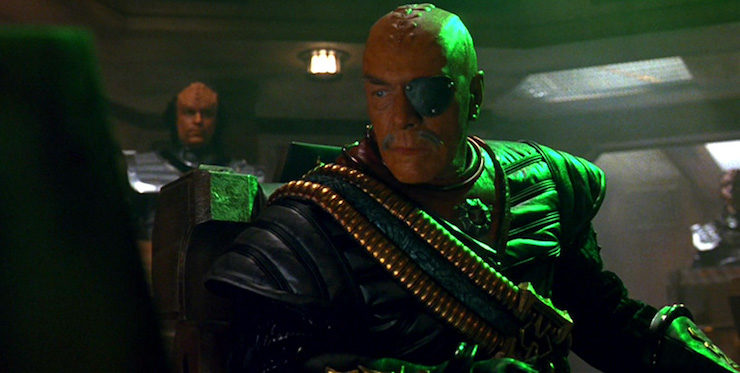
Meanwhile on Khitomer, the president and Azetbur discuss the peace process. A Klingon gets up and walks out of the conference, setting up a sniper rifle, intending to kill both the president and Azetbur. Kirk, Spock, Scotty, Chekov, Uhura, and Valeris beam down—the latter there mainly as evidence of her confession—as does Sulu with a landing party of his own. Cartwright and Nanclus are taken into custody, and Scotty shoots the sniper—who turns out not to be Klingon. Worf and the C-in-C unmask him to reveal West. Kirk makes a speech about how the future shouldn’t be the end of history and how important it is to finish Gorkon’s work. Everyone applauds.
Sulu says it’s good to see Kirk in action one last time, and Excelsior buggers off. Uhura reports that they’ve been ordered to return to Earth for decommissioning. Spock says that if he were human, his response to those orders would be, “Go to hell.” Kirk orders Chekov to set a course for the second star to the right and straight on til morning. Then he gives a benedictory log entry that wishes well to the next folks who command a ship called Enterprise, boldly going where no man—where no one has gone before.
Can’t we just reverse the polarity? The Klingons have developed a ship that can fire while cloaked, because the plot won’t work otherwise.
Fascinating. Spock is the one who—at Sarek’s urging—starts the dialogue with Gorkon following Praxis’s destruction. He, like most of the rest of the crew, is retiring, and he’s obviously getting ready to enter the diplomatic service, like his father, as seen in TNG when he’s an ambassador.
I’m a doctor not an escalator. McCoy tries heroically to save Gorkon even though he professes right there as he’s doing it that he doesn’t know much about Klingon anatomy. So how much good was he supposed to be doing, exactly? He also helps Spock modify the torpedo, because why use an engineer to do technical work when you can have one of your main characters violate his Hippocratic Oath?
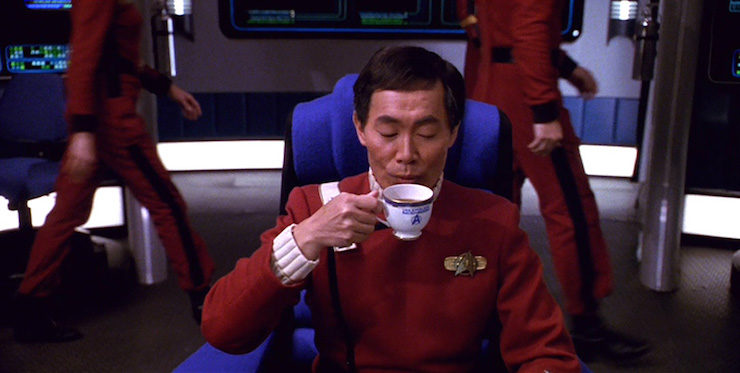
Ahead warp one, aye. Sulu finally gets the command he got in the script for The Wrath of Khan, as the movie opens with him in charge of the Excelsior, and also has him play a critical role in the climax.
Hailing frequencies open. Uhura inexplicably has absolutely no knowledge of the Klingon language whatsoever, nor is the Enterprise computer programmed with any information about it, since she and a half-dozen others are poring over a ton of codex books about the language.
I cannot change the laws of physics! Scotty accuses Azetbur of killing Gorkon herself, calling her “that Klingon bitch,” and opining to Spock that Klingons don’t value life “the way we do.” Yeah.
It’s a Russian invention. While he, Spock, and Valeris are searching the galley, Chekov doesn’t understand why the saboteurs didn’t just vaporize the boots. Valeris grabs a phaser (they keep phasers in the galley????) and vaporizes a stewpot, which immediately sets off an alarm. Chekov is supposed to be chief of security, you’d think he’d know this. Adding insult to injury, both Uhura and Scotty enter the galley asking if someone fired a phaser set on vaporize, so they both know this, and Chekov doesn’t?
Go put on a red shirt. Burke and Samno prove the perfect fall guys for Valeris, as they think all Klingons look alike and smell bad, and so she easily conscripts them to commit regicide and then she can later murder them with impunity, as they’re racist, murdering assholes.
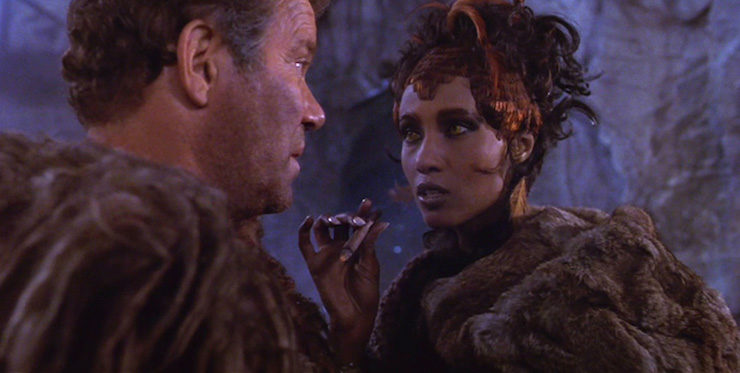
No sex, please, we’re Starfleet. After Martia kisses Kirk, McCoy just stares at him and asks, “What is it with you?”
Channel open.
“She doesn’t know.”
“Then we’re dead.”
“I have been dead before.”
–Spock determining that Valeris doesn’t have a vital bit of intel, Scotty lamenting this, and Spock making a funny.
Welcome aboard. The big guests are master thespians David Warner and Christopher Plummer playing Klingons, the former as Gorkon and the latter as Chang. Warner previously appeared in the last film as Talbot and will be on TNG as Gul Madred in the “Chain of Command” two-parter.
Back from The Voyage Home are Mark Lenard as Sarek, Brock Peters as Cartwright, and John Schuck as the Klingon ambassador. It’s the final appearance by all three as those characters, though Lenard has two chronologically later appearances on TNG that predate this movie, in “Sarek” and “Unification I.” The character of Sarek will subsequently be seen in the 2009 Star Trek played by Ben Cross and the upcoming Discovery played by James Frain, both chronologically prior to this film. Peters will next appear as Joseph Sisko in DS9‘s “Homefront,” while Schuck will next be in DS9‘s “The Maquis Part 2” as a Cardassian legate.
The Federation president is the first of three Trek roles for Kurtwood Smith, who will return on DS9 as Thrax in “Things Past” and Voyager as Annorax in “Year of Hell.” The C-in-C is the first of two Trek roles for Leon Russom, who will play Vice Admiral Todman in DS9‘s “The Die is Cast.” The Rura Penthe warden is the second of four Trek roles for W. Morgan Sheppard, who played Ira Graves in TNG‘s “The Schizoid Man” and will go on to play Qatai in Voyager‘s “Bliss” and the head of the Vulcan Science Council in the 2009 Star Trek.
Rosanna DeSoto plays Azetbur, Kim Cattrall plays Valeris, Paul Rossilli plays Kerla, and Iman plays Martia.
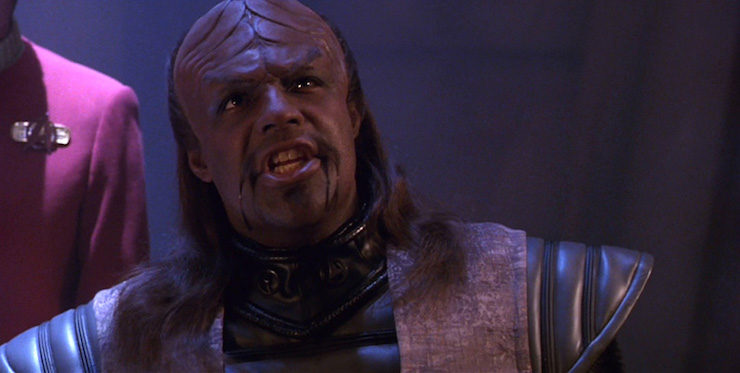
Michael Dorn appears as the Klingon lawyer assigned to defend Kirk and Spock. Credited only as “Klingon Defense Attorney,” he is named “Colonel Worf” in dialogue, and it was always the intention of both scriptwriters that he be the grandfather of the same-named character Dorn played on TNG and DS9.
Rene Auberjonois plays West. All his scenes were deleted from the theatrical release, but were restored on home video. Auberjonois would two years later be cast in the regular role of Odo on DS9, and also play Ezral in Enterprise‘s “Oasis.”
Christian Slater, the son of casting director Mary Jo Slater and a longtime Trek fan, makes an uncredited cameo as a member of the Excelsior crew. Also appearing as Excelsior crew are Jeremy Roberts as Valtane and Boris Lee Krutonog as Lojur, who both will return in Voyager‘s “Flashback.”
And, finally, we have the usual suspects of James Doohan, George Takei, Nichelle Nichols, and Walter Koenig, as well as Grace Lee Whitney. Doohan will next be seen in TNG‘s “Relics,” and both Takei and Whitney will next be seen in “Flashback.”
Trivial matters: This is the last time the entire cast of the original series will all be together on screen. Kirk, Chekov, and Scotty are next seen in Generations, with Scotty also appearing in TNG’s “Relics.” Sulu will next be seen in Voyager’s “Flashback” (the events of which are concurrent with this film). Spock’s next chronological appearance will be TNG‘s “Unification” two-parter, which aired a month before this film’s release (those episodes also have a few callbacks to this movie), and he will next appear in the 2009 Star Trek. This is the last appearance of Nichelle Nichols as Uhura and DeForest Kelley as McCoy, though the latter’s next chronological appearance is in TNG‘s “Encounter at Farpoint” (which aired four years prior to this); both characters are next seen in the 2009 Star Trek, played respectively by Zoë Saldana and Karl Urban.
This was the last Trek movie made in Gene Roddenberry’s lifetime. He saw a screener of the film two days before he died in October 1991, two months before its theatrical release. The movie was dedicated to him.
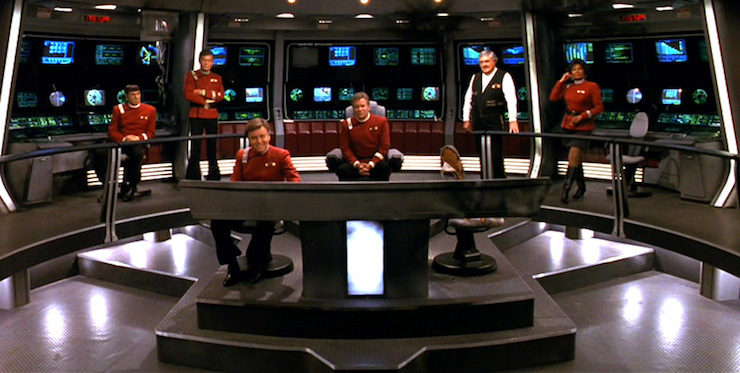
The Klingons and Federation were established as allies in the 24th century implicitly by Worf’s presence on the Enterprise bridge in uniform in “Encounter at Farpoint.” The alliance was more formally established in “Heart of Glory,” and was borne of Roddenberry wanting to show that Ayelborne’s prediction in “Errand of Mercy” would come true, that the Federation and Klingons would become fast friends. This movie, made in the wake of glasnost and the end of the Cold War between the U.S. and the Soviet Union, shows the process by which that alliance got started, complete with a Klingon chancellor whose name was inspired by Soviet Premier Mikhail Gorbachev, the architect of glasnost.
The dismal box office and reception for The Final Frontier meant this film almost wasn’t made, but the higher-ups at Paramount a) wanted to do something for Trek‘s 25th anniversary in 1991 and b) didn’t want the previous movie to be the original crew’s swan song. However, they also didn’t want this movie to cost any more to make than the fifth one, so Harve Bennett proposed a Starfleet Academy movie that could be done with younger and cheaper actors. However, the president of Paramount, Roddenberry, and the fanbase (when the notion was leaked) all rejected the notion vociferously, at which point Bennett quit in a huff. Leonard Nimoy was approached to develop the film, and he both suggested a glasnost allegory with the Federation and Klingons and requested that Nicholas Meyer be brought in. According to Nimoy, Meyer, and William Shatner, while Lawrence Konner & Mark Rosenthal were given co-story credit, nothing of theirs is actually in the movie. (They were hired at Paramount’s insistence.)
Nichelle Nichols and Brock Peters both had difficulty with lines given to them expressing racist attitudes toward the Klingons, using language that has been used in relation to African Americans. Nichols out-and-out refused to say, “Guess who’s coming to dinner?” and the line was transferred to Chekov.
Nichols also objected to Uhura being unfamiliar with the Klingon language, since as communications officer it would behoove her to be familiar with the language of the Federation’s enemies. Meyer overruled her. Interestingly, Star Trek Into Darkness will establish that Uhura is fluent in Klingon.
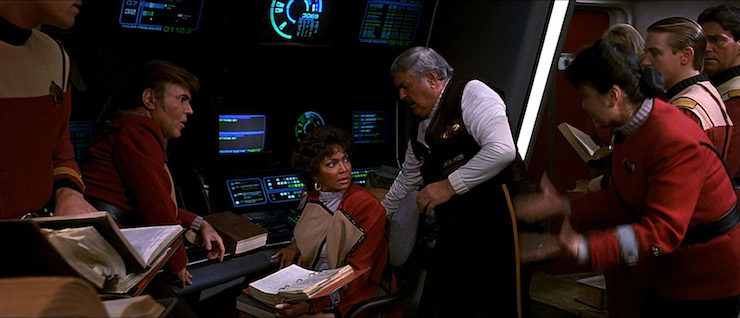
Both James Horner (who scored The Wrath of Khan and The Search for Spock) and Jerry Goldsmith (who scored The Motion Picture and The Final Frontier) were approached to score this film, but they both declined, leading to Cliff Eidelman being hired.
Sulu will again be seen in charge of the Excelsior in Voyager‘s “Flashback,” where it’s established that Tuvok was part of his crew at the time of this movie. The number of appearances made by Sulu and the Excelsior in the tie-in fiction are too numerous to list, but among them are The Sundered and Forged in Fire by Andy Mangels & Michael A. Martin, The Captain’s Daughter by Peter David, The Fearful Summons by Denny Martin Flynn (one of the writers of this film), The Last Roundup by Christie Golden, and One Constant Star by David R. George III, as well as several appearances in DC’s monthly Star Trek comic written by Howard Weinstein, as well as Marvel’s Star Trek Unlimited #8 written by Dan Abnett & Ian Edginton and IDW’s Captain’s Log: Sulu written by Scott & David Tipton.
Both Kirk’s middle name of Tiberius and Sulu’s first name of Hikaru are spoken aloud for the first time in live action here. Tiberius was previously used on the animated series in “Bem.” Hikaru was first used in the 1981 novel The Entropy Effect by Vonda N. McIntyre, and was given as Sulu’s first name extensively in the tie-in fiction thenceforth. It’s a rare instance of the tie-in fiction influencing something appearing onscreen. (Peter David was on the set when George Takei filmed the Excelsior scenes, and he encouraged Takei to use the first name for his log entry, which is how it got in there.)
Uhura is mistakenly credited as “Uhuru” in the closing credits.
Kronos is established as the name of the Klingon homeworld, thus supplanting “Kling,” briefly and hilariously used in “Heart of Glory.”
Khitomer had already been established as the site of a Klingon base attacked by Romulans (an attack that killed Worf’s parents) in TNG‘s “Heart of Glory” and “The Neutral Zone.” Your humble rewatcher dramatized that attack in the novel The Art of the Impossible. The peace treaty between the Federation and Klingons that resulted from the events of this movie will be established in DS9’s “The Way of the Warrior” as the Khitomer Accords.
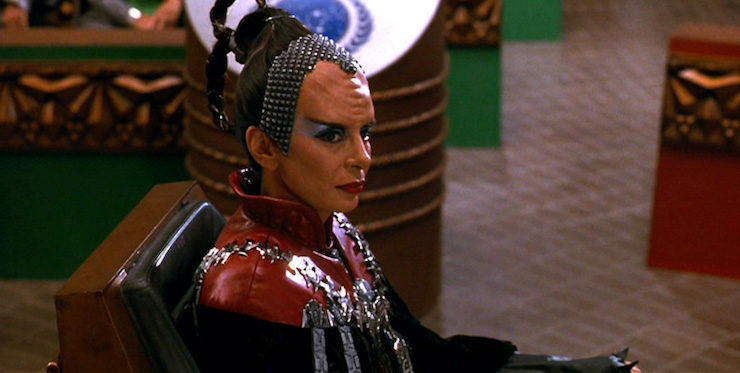
Klingon blood is fuschia colored in this film, the only time in the five decades that Klingons have been shown onscreen that their blood has been anything other than red.
The Klingon love of Shakespeare seen in this film has inspired several Klingon translations of the Bard’s work, including The Klingon Hamlet. When he created the Klingon language two movies previous, Marc Okrand deliberately made the language not have the verb “to be.” And then he was asked to provide the phrase, “to be or not to be” in Klingon.
Gorkon and Azetbur are both identified as the chancellor of the Klingon High Council. This title will retroactively be applied to the 24th-century leaders of the empire (K’mpec, Gowron, Martok) in “The Way of the Warrior.”
Gorkon appears in the Vanguard novel series by David Mack, Dayton Ward, and Kevin Dilmore, the Legacies trilogy by Greg Cox, Mack, Ward, & Dilmore, In the Name of Honor by Ward, and the Errand of Vengance and Errand of Fury trilogies by Kevin Ryan as an up-and-comer in the Klingon Empire. His history with Chang is chronicled in the Klingon Academy video game. A Federation starship will be named after him in the 24th century, as seen in “Descent.” In addition, your humble rewatcher will establish the Chancellor-class of heavy cruiser developed in the Klingon Defense Force and launched after the Dominion War, where all the ships are named after past chancellors, including ships named Gorkon and Azetbur.
Azetbur appears in the novels Sarek by A.C. Crispin and Serpents Among the Ruins by David R. George III, as well as the novella Its Hour Come Round by Margaret Wander Bonanno (part of the Mere Anarchy miniseries). Serpents shows her reign’s end at the wrong end of an assassin’s blade. TNG‘s “Redemption” established that women cannot serve on the High Council; Azetbur’s becoming chancellor seems to contradict this, but your humble rewatcher established in The Art of the Impossible and The Klingon Art of War that Azetbur’s reactionary successor Kaarg immediately passed the law that women could not serve on the council as an extreme reaction to Azetbur’s regime.
This movie is one of three times we see a change of power in the Klingon Empire. The other two—in TNG‘s “Reunion” and DS9‘s “Tacking Into the Wind“—involve someone winning a challenge to earn the chancellorship. This is the only time it’s seen as hereditary, and your humble rewatcher established in The Klingon Art of War that the naming of an heir was a tradition among Klingon emperors before the ascension of the High Council to control of the empire, and Gorkon revived that tradition with Azetbur.

Colonel Worf is seen again in The Art of the Impossible, where he’s been promoted to general by the early 24th century. He is killed in that novel, and it’s established that his son, Mogh, names his first-born son after him, thus fulfilling the intention of the scriptwriters of this film that Dorn be playing his own grandfather.
The events of this film provide the frame for the comic book miniseries Blood Will Tell written by Scott & David Tipton, as several Klingons look at past relations between the Federation and Klingons while trying to figure out how to proceed in the wake of Praxis’s destruction.
Several novels establish that Uhura starts a career in Starfleet Intelligence in the 24th century, with the seeds being sown by her attendance at the Khitomer Conference, among them the Lost Era novels Catalyst of Sorrows by Margaret Wander Bonanno and the aforementioned The Art of the Impossible, as well as the novels Vulcan’s Forge, Vulcan’s Heart, and the Vulcan’s Soul trilogy by Josepha Sherman & Susan Shwartz.
The “Unification” two-parter on TNG will establish that Spock met Senator Pardek at the Khitomer Conference. Pardek would be instrumental in getting Spock to go underground to Romulus in those episodes.
The DS9 episode “Blood Oath” established that Curzon Dax negotiated many treaties between the Federation and Klingons, and “You Are Cordially Invited…” formally established that Curzon helped negotiate the Khitomer Accords. Several novels—Forged in Fire, The Art of the Impossible, etc.—established that Curzon started his diplomatic career as an aide to Sarek.
Rura Penthe will be seen again in an earlier timeframe in Enterprise‘s “Judgment,” which will also have a Klingon court very similar to the one seen in this movie. It was also in the script for the 2009 Star Trek as the prison where Nero and his people were imprisoned for the twenty-five years between when George Kirk was killed and the primary events of the movie, but the reference was cut. That imprisonment is dramatized in the Nero comic book miniseries written by Tim Jones & Mike Johnson.
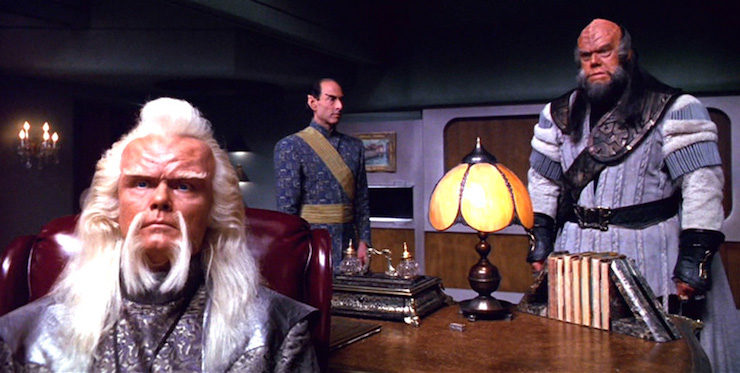
This movie establishes that the president’s office is in Paris. The Voyage Home has the president and the Federation Council meeting in San Francisco at Starfleet Headquarters, which never entirely made sense. The president’s office will still be in Paris when we see it next onscreen in DS9‘s “Homefront” and “Paradise Lost.” The building that houses the president’s office and the Federation Council Chambers is identified in David Mack’s A Time to Kill as the Palais de la Concorde (located on the Place de la Concorde in the City of Light), and the tie-in fiction has continued to use that designation, including in your humble rewatcher’s Articles of the Federation, the aforementioned Errand of Vengeance and Errand of Fury trilogies, and the Typhon Pact series, among others. (Some have theorized that the Council meets in San Francisco, while the president’s office remains in Paris, but it really doesn’t make sense that the president operates in a position that is separated from the council by eight time zones.)
The president is not named in the script, but J.M. Dillard’s novelization referred to his as Ra-ghoratreii. The novelization identified him as Deltan, but all other sources have had him be Efrosian (named after unit production manager Mel Efros, who worked on the previous two films; an Efrosian was also seen as a crew member of the Saratoga in The Voyage Home). Ra-ghoratreii will also be seen in tons of tie-in fiction, including the novels The Ashes of Eden by William Shatner with Judith & Garfield Reeves-Stevens, the aforementioned Sarek, and the Crucible trilogy by David R. George III, and the novella The Blood-Dimmed Tide by Howard Weinstein (part of the Mere Anarchy series). Articles of the Federation established that one of the conference rooms in the Palais de la Concorde is named after him.
The commander in chief is just called “Bill” in the script, but the novelization gives his last name as Smillie. The character will appear again in Forged in Fire and the Crucible trilogy.
Chang’s Shakespeare quotes come from Hamlet, Julius Caesar, Henry IV Part II, Henry V, The Merchant of Venice, Richard II, Romeo and Juliet, and The Tempest. Gorkon and Martia both quote Hamlet as well. In addition, there are references to Richard Nixon (“Only Nixon could go to China”), Sherlock Holmes (“if you eliminate the impossible, whatever remains, however improbable, must be the truth”—Meyer wrote three Holmes novels, one of which, The Seven Per-Cent Solution, he also adapted into a screenplay), Adlai Stevenson (“Don’t wait for the translation, answer me now!”), The Bridge on the River Kwai (the Rura Penthe warden’s speech to the new inmates), and Peter Pan (Kirk’s course request at the end).
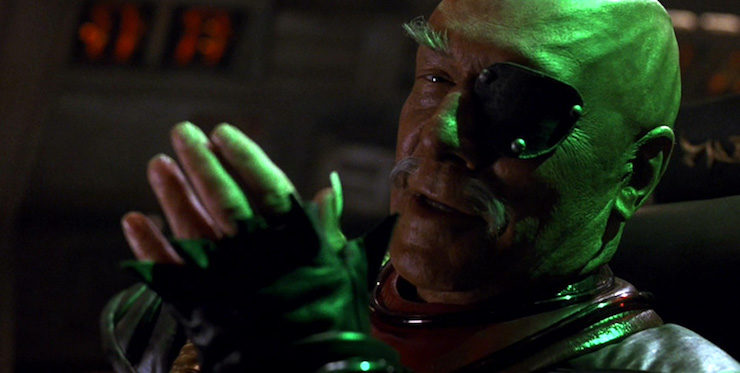
Early drafts of the script had Saavik in the role that eventually became Valeris. Kirstie Alley declined to return, and Nicholas Meyer did not like Robin Curtis‘s portrayal, and rather than cast a third actor in the same role, they created the new character. Valeris‘s backstory and eventual fate are chronicled in the novel Cast No Shadow by James Swallow. She also appears in the DC comic book Star Trek Special #2 written by Steven H. Wilson, where she encounters Saavik at a point prior to this film. The Mirror Universe version of Valeris is seen in David Mack’s The Sorrows of Empire, where she tries to assassinate Emperor Spock, but is stopped by Saavik.
In addition to Dillard’s novelization, this film was adapted into comic-book form by Peter David, Gordon Purcell, & Arne Starr. Both the novelization and the comics adaptation included a dialogue exchange from the script between Sulu and Valtane, where the latter says that he’s committed treason, and Sulu replies, “I always hoped that if I ever had to choose between betraying my country or betraying my friend, I’d have the courage to betray my country,” echoing a line from E.M. Forster’s essay “What I Believe.” The scene was cut from the movie.
To boldly go. “Cry havoc! And let slip the dogs of war!” This movie utterly destroys the characters of Kirk and Spock for plot expediency, and while it’s the most revolting crime committed by this misbegotten disaster of a movie, it’s far from the only one.
Let’s get this out of the way: Kirk orders Spock to rape Valeris. Yes, that’s a charged comment; yes, that’s a serious allegation; yes, that’s utterly revolting. But it’s completely true. And just in case we’re not sure, Meyer films it that way, with Spock looming over Valeris, grabbing her arm, yanking her toward him when she tries to back off, and maintaining a firm grip on her hair while performing the meld. It’s a horrid act, a despicable violation of a person, and one that should never have been committed by people we have two-and-a-half decades of seeing as heroes up to this point.
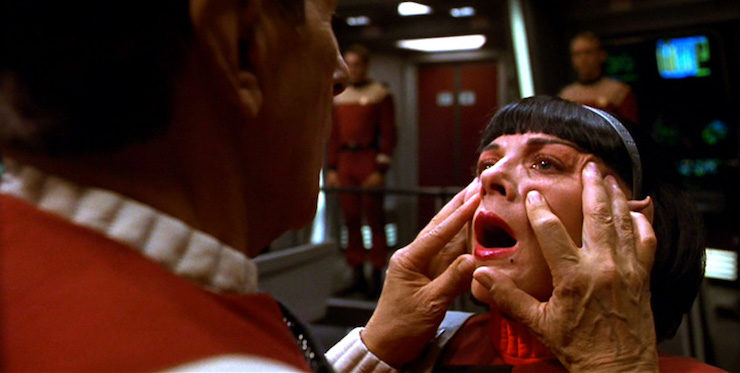
But it’s just the latest in a series. None of the crew comes off well here. Kirk’s “Let them die!” is a horrifically bloodthirsty response from the guy who twice spoke of how the most important thing a person can decide is “I will not kill today,” who publicly upbraided one of his officers for his bigotry toward Vulcans and Romulans, and whose hallmark has been to seek out a compassionate response over a violent one where at all possible. Yes, yes, yes, a Klingon killed the son he barely knew three movies ago. That doesn’t make what he says any less revolting, and the fact that he goes along with being the Federation’s olive branch only reluctantly and whining like a four-year-old does nothing to make the character look like anything other than a racist shithead.
In that, he’s in good company. The dinner is a rhapsody in awkward, but Chekov and Uhura’s bitching about their table manners just because their culture involves eating with their hands comes across as the worst kind of racist, classist snobbery. When Spock acidly reminded them how shitty they all behaved, I was cheering.
This movie is full of racially charged commentary by our theoretical heroes, from Scotty’s line about how they don’t respect life the way we do to Cartwright’s alien trash line to Chekov’s citing the title of a movie about racist attitudes to Uhura’s gawking at the Klingons eating. To have such behavior from Uhura—played by an actor who was convinced to stay in the role due to its importance by Martin Luther King Jr. his own self—is a howlingly high level of tone-deafness. It’s to her credit that she out-and-out refused to say, “Guess who’s coming to dinner?” though the line is no better coming out of a white guy than it would be a black woman.
This wouldn’t be so bad if there was any kind of history of racist attitudes on the part of the Federation toward Klingons, but there really isn’t. The only time we’ve seen such is in “Day of the Dove,” and that was artificially imposed by the swirly thing, and that episode ended with the two crews cooperating and laughing together. The differences between the Federation and Klingon Empire has been portrayed, since “Errand of Mercy,” as political, not racial.
The hallmark of Star Trek when it debuted in 1966 was that it showed a united Earth, that we had put aside our differences, so that the bridge can have Russians, Asians, Africans, Europeans, and Americans all working together without it remotely being an issue. So for the show to celebrate its 25th anniversary by portraying the good guys as unrepentant racists is an insult to what made the show so important and groundbreaking in the first place. Some of them stay unrepentant, too! At the end, Uhura says that she feels the same as Valeris, even after everything is over, which is yet another notch on the character assassination belt, as Uhura has just sympathized with someone who murdered two of their crewmates in cold blood.
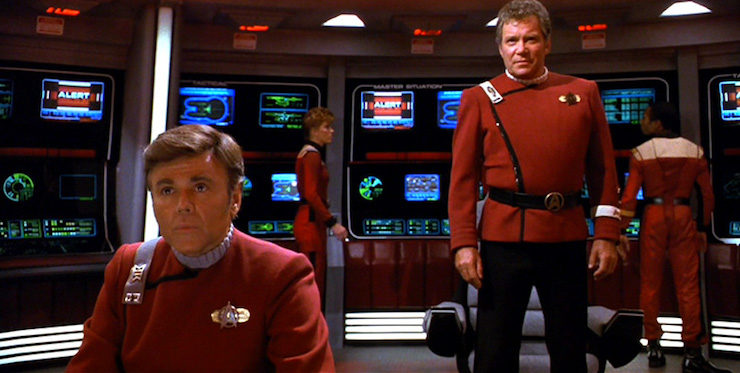
The only characters who come out unscathed are Saavik and Sulu, the former by the unwillingness to re-cast the role, so we get Valeris instead, the latter by virtue of being on another ship. Speaking as someone who always loved the character of Sulu, seeing him get his own command is a very nice touch, and gives him a big role to play in the story without stealing the spotlight from the big three. Uhura, Chekov, and Scotty are less well served by being stuck on the Enterprise, especially since the movie keeps marginalizing them to build up Valeris to make the reveal about her more effective, at which they’re only partially successful. As it is, Valeris’s betrayal isn’t much of a surprise, because who else could it be? While making our heroes into jerks is acceptable, making them into murderers would not be, and there’s nobody else on the ship who even has a speaking part.
Even leaving aside the character assassination, the racism, the rape—this is still a dumb movie. The entire plot is predicated on fear that Starfleet will be mothballed, as if the only reason Starfleet exists is to combat Klingons, which makes no sense. (There’s even a Romulan right there in the story. Plus, the whole seek-out-new-life-and-new-civilizations thing, which you’d think somebody would have remembered since it’s spoken at the top of every episode of the show, and was also used in two prior movies.) Somehow, Starfleet computers don’t have any information about Klingon language, and they have to consult a huge pile of books in order to communicate. And what if the listening post wasn’t run by a bored drunk? And that’s one of several scenes that are played for laughs that are forced and unconvincingly stupid (e.g., the revelation about Dax’s feet, “only Nixon could go to China”). When Excelsior and Enterprise battle Chang’s Bird-of-Prey, where are all the other ships in orbit? (The delegates to the conference had to get there somehow.)
The movie is not a total disaster. As I said, seeing Sulu in command of his own ship is a joy to see, and is the sort of thing we should have seen more of beyond this and Chekov’s being on the Reliant four movies ago—these people have grown older and should have actually advanced more in their careers. Christopher Plummer is simply superb as Chang, a wonderful antagonist. David Warner and Rosanna DeSoto both bring gravitas to their roles, with DeSoto in particular showing the struggle between two responses to her father’s death: revenge for his murder and needing to finish the work he started. Kurtwood Smith has similar gravitas as the president, trying to balance several different needs and agendas, and Leon Russom also gets credit for bringing some nuance that neither Brock Peters nor Rene Auberjonois are allowed to have (which is too bad, as both actors deserved better than this).
And in the abstract, the movie does a good job of showing the process of peace and alliance that had already been established as happening eight decades of story-time hence. The general storyline does a good job of showing the start of the road that led to Worf on the bridge of the Enterprise (casting Michael Dorn as his own ancestor is a nice nod to that, as well).
But this crew deserved a better sendoff than to be portrayed as racist relics who blithely commit horrid acts. By ordering Spock to commit rape, Kirk is no better than the allegedly untrustworthy Klingons, and Spock—the only member of the Enterprise crew who doesn’t come across as prejudiced—goes along with it unhesitatingly. Before this movie, I was sad to learn that this was the last hurrah for the Big Seven. After this movie, I never particularly wanted to see them again.
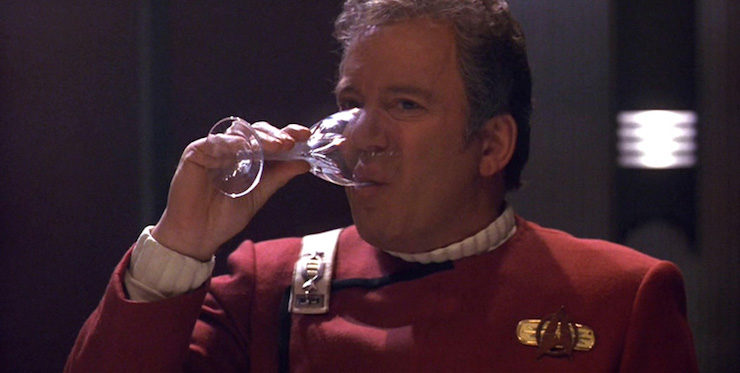
Warp factor rating: 2
Next week: Star Trek Generations
Keith R.A. DeCandido has several upcoming items available for preorder: Orphan Black: Classified Clone Report, out in August from Insight Editions (just in time for that series’ final episode); Nights of the Living Dead, edited by George Romero & Jonathan Maberry, which ties into the classic zombie film, with Keith’s story “Live and On the Scene,” out in July; Joe Ledger: Unstoppable, set in Maberry’s horror/thriller oeuvre, with Keith’s story “Ganbatte” featuring Lydia “Warbride” Ruiz, due in October; Stargate SG-1/Atlantis: Homeworlds, edited by Sally Malcolm, with Keith’s Carter-and-Teal’c story “Sun-Breaker,” out in eBook this month and print next month; and the omnibus Marvel’s Tales of Asgard, which collects Keith’s three novels Thor: Dueling with Giants, Sif: Even Dragons Have Their Endings, and Warriors Three: Godhood’s End, out in August (just in time for the release of Thor: Ragnarok).










